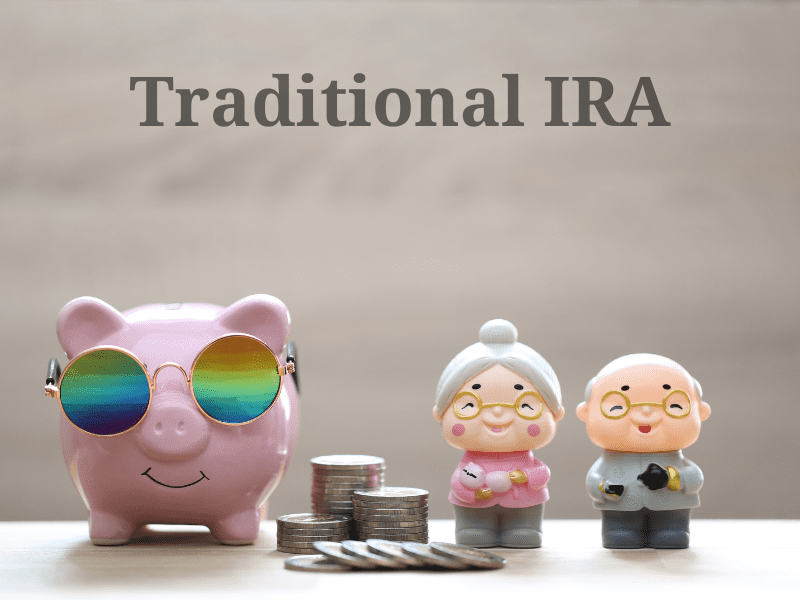Understanding the Basics of a Traditional IRA
A traditional IRA, short for Individual Retirement Account, is a popular retirement savings tool that offers tax advantages to individuals. It allows individuals to contribute pre-tax income towards their retirement savings, helping them build a nest egg for their golden years.
The key feature of a traditional IRA is its tax-deferred nature. This means that contributions made to the account are not taxed in the year they are made. Instead, taxes on both the contributions and any earnings are deferred until withdrawals are made during retirement.
Individuals can contribute up to a certain limit each year, which is determined by the Internal Revenue Service (IRS). The contribution limits may vary depending on factors such as age and income level.

One of the main advantages of a traditional IRA is that it provides individuals with an opportunity to lower their taxable income in the present while potentially benefiting from lower tax rates during retirement. This can be particularly advantageous for those who expect their income to decrease after retiring.
In addition to its tax benefits, a traditional IRA offers individuals flexibility in terms of investment options. Depending on the financial institution where the account is held, individuals can choose from various investment vehicles such as stocks, bonds, mutual funds, and more.
It’s important to note that there are rules and restrictions associated with traditional IRAs. For example, there may be penalties for early withdrawals before reaching a certain age or failing to meet required minimum distributions during retirement.
Understanding the basics of a traditional IRA is essential for anyone looking to maximize their retirement savings potential while taking advantage of tax benefits. By contributing regularly and making informed investment decisions within this type of account, individuals can work towards achieving financial security during their golden years.
Table of Contents
Tax Advantages: The Key Benefit of Contributing to a Traditional IRA
Contributing to a Traditional IRA offers numerous tax advantages, making it an attractive option for individuals looking to save for retirement. One of the key benefits is the ability to make tax-deferred contributions. This means that the money you contribute to your Traditional IRA is not subject to taxes at the time of contribution. Instead, it grows tax-deferred until you withdraw it in retirement.
Additionally, contributions made to a Traditional IRA may be tax-deductible, depending on your income level and whether you or your spouse have access to an employer-sponsored retirement plan. By deducting your contributions from your taxable income, you can potentially lower your overall tax liability for the year.
Lowering your taxable income through deductible contributions can have significant financial advantages. Not only does it reduce the amount of income that is subject to taxes in the current year, but it also allows you to potentially defer paying taxes on those funds until you withdraw them in retirement when you may be in a lower tax bracket.
It’s important to note that while there are clear tax benefits associated with contributing to a Traditional IRA, there are also certain limitations and eligibility requirements that individuals should consider. Consulting with a financial advisor or tax professional can help ensure that you maximize these benefits and make informed decisions regarding your retirement savings strategy.
Long-Term Savings and Growth Potential
Planning for retirement involves considering long-term savings and growth potential. One of the key factors that can contribute to the growth of retirement savings is compound interest. Compound interest allows your money to grow exponentially over time, as you earn interest not only on your initial investment but also on the accumulated interest.
Investment opportunities play a crucial role in maximizing long-term savings and growth potential. By diversifying your portfolio and investing in various assets such as stocks, bonds, mutual funds, or real estate, you can potentially benefit from higher returns and mitigate risks.
Retirement planning involves setting realistic financial goals and creating a strategy to achieve them. It is essential to consider factors such as inflation, life expectancy, and desired lifestyle during retirement when determining how much to save and invest.
By starting early and consistently contributing to retirement accounts such as 401(k)s or IRAs, individuals can take advantage of compounding effects over a longer period. Additionally, seeking professional advice from financial advisors can help optimize investment strategies tailored to individual goals and risk tolerance.
In summary, long-term savings growth for retirement requires careful consideration of compound interest, exploring investment opportunities, and developing a comprehensive retirement plan. By taking proactive steps towards saving and investing wisely, individuals can work towards securing their financial future during their golden years.
Flexibility and Control over Your Retirement Savings
Flexibility and control over your retirement savings are crucial aspects when it comes to planning for a secure financial future. Understanding the various investment options, contribution limits and deadlines, as well as withdrawal rules and penalties, can help you make informed decisions about managing your retirement funds.
When it comes to investment options, individuals have a range of choices depending on their risk tolerance and financial goals. Common options include stocks, bonds, mutual funds, and real estate. Each option carries its own level of risk and potential return, so it’s important to carefully evaluate and diversify your portfolio to mitigate risk.
Contributions to retirement accounts are subject to annual limits set by the government. These limits may vary depending on the type of account you have, such as a 401(k), IRA, or Roth IRA. It’s essential to be aware of these limits and contribute accordingly in order to maximize your savings potential.
Additionally, understanding contribution deadlines is crucial for taking full advantage of tax benefits associated with retirement accounts. Contributions made before the tax filing deadline for a given year can often be deducted from taxable income or qualify for tax-free growth.
Withdrawal rules should also be considered when planning for retirement. Different types of retirement accounts have different rules regarding when and how much you can withdraw without penalties. For example, early withdrawals from traditional IRAs or 401(k)s may result in taxes owed plus an additional penalty fee.
Having flexibility and control over your retirement savings allows you to adapt your strategy based on changing circumstances or financial goals. By staying informed about investment options, contribution limits and deadlines, as well as withdrawal rules and penalties, you can make informed decisions that align with your long-term financial objectives while maximizing the potential growth of your retirement funds.
Rollover Options and Portability Benefits
Rollover options and portability benefits play a crucial role in managing retirement savings when individuals change jobs or retirement plans. One of the key aspects of this process is the utilization of rollover IRAs, which allow individuals to transfer funds from their previous employer-sponsored retirement plans into an individual retirement account (IRA).
Changing jobs or retirement plans can often lead to confusion about what to do with the accumulated funds in a previous employer’s retirement plan. Rollover IRAs offer a solution by providing a seamless way to preserve and continue growing these funds.

By transferring funds between accounts through a rollover IRA, individuals can maintain control over their retirement savings and avoid penalties or taxes that may be incurred if they were to withdraw the funds directly. This process allows for flexibility in investment choices, as individuals can select from a wide range of investment options available within their chosen IRA provider.
Portability benefits also come into play when considering rollover options. With the ability to transfer funds between accounts, individuals are not tied down to one specific employer-sponsored plan. This portability allows for greater control over investments and ensures that retirement savings are not left behind when transitioning between jobs or retiring.
In summary, rollover options and portability benefits provide individuals with the flexibility and control needed to manage their retirement savings effectively. By utilizing rollover IRAs and transferring funds between accounts, individuals can navigate job changes or retirement plans with ease while preserving and growing their hard-earned savings.
Tax Strategies for Maximizing the Benefits of a Traditional IRA Contribution
When it comes to maximizing the benefits of a traditional IRA contribution, there are several tax strategies that individuals can employ. One such strategy is Roth conversions, which involve converting funds from a traditional IRA to a Roth IRA. By doing so, individuals can potentially take advantage of tax-free withdrawals in retirement.
Another important consideration is required minimum distributions (RMDs). Once individuals reach the age of 72 (70 ½ if born before July 1, 1949), they are generally required to start taking RMDs from their traditional IRAs. However, by strategically planning these distributions and considering factors such as other sources of income and tax brackets, individuals can minimize the tax impact of RMDs.
Estate planning considerations also play a role in maximizing the benefits of a traditional IRA contribution. By carefully designating beneficiaries and utilizing strategies such as stretch IRAs or trusts, individuals can ensure that their heirs receive the maximum benefit from the account while minimizing potential estate taxes.
It is important to note that these tax strategies should be implemented with careful consideration and consultation with a financial advisor or tax professional. Each individual’s situation is unique, and what works for one person may not be suitable for another.
Enjoy the Benefits of Tax-Advantaged Retirement Savings with a Traditional IRA Contribution
In conclusion, contributing to a Traditional IRA offers numerous benefits for individuals looking to maximize their retirement savings in a tax-advantaged manner. By making regular contributions to a Traditional IRA, individuals can take advantage of the tax benefits associated with this type of retirement account.
One of the primary advantages of a Traditional IRA is the potential for tax deductions on contributions. Individuals may be eligible to deduct their contributions from their taxable income, reducing their overall tax liability for the year. This can result in significant savings, especially for those in higher tax brackets.
Additionally, funds within a Traditional IRA grow on a tax-deferred basis. This means that any investment gains or earnings within the account are not subject to immediate taxation. Instead, taxes are deferred until withdrawals are made during retirement when individuals may be in a lower income bracket.

Furthermore, contributing to a Traditional IRA allows individuals to take advantage of compounding growth over time. By consistently contributing and allowing investments within the account to grow, individuals have the opportunity to accumulate substantial retirement savings over the long term.
It’s important to note that there are contribution limits and eligibility requirements for Traditional IRAs based on factors such as age and income level. Therefore, it is advisable for individuals considering this type of retirement account to consult with a financial advisor or tax professional who can provide personalized guidance based on their specific circumstances.
In summary, making regular contributions to a Traditional IRA offers individuals an opportunity to enjoy the benefits of tax-advantaged retirement savings. By taking advantage of potential tax deductions and allowing investments within the account to grow on a tax-deferred basis, individuals can enhance their ability to build wealth and secure financial stability during their golden years.


4 thoughts on “The Primary Benefit of Contributing to a Traditional IRA: An Overview”